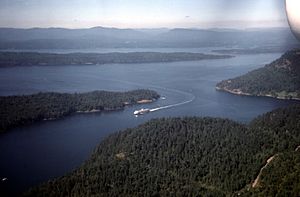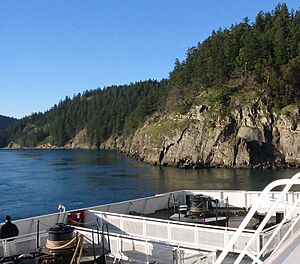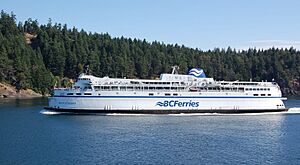Active Pass facts for kids
Active Pass is a narrow waterway, like a river, located in the beautiful Gulf Islands of British Columbia, Canada. It separates two islands, Galiano Island to the north and Mayne Island to the south. This important pass connects the Trincomali Channel in the west with the larger Strait of Georgia in the east. It is about 5.5 kilometers (3.4 miles) long and has two sharp turns.
Contents
What's in a Name?
Active Pass got its name from a ship called the USCS Active. This ship belonged to the United States Navy. It was the first steam-powered vessel to travel through the pass way back in 1855.
A Busy Waterway
Today, Active Pass is a very busy place! It is mainly used by BC Ferries. These ferries carry passengers and vehicles between Tsawwassen on the mainland and Swartz Bay on Vancouver Island. They also stop at some of the southern Gulf Islands.
Because the pass is quite narrow, the large ferries pass very close to the shore. This makes for an exciting view from the ferry deck! Besides ferries, you can also see:
- Small pleasure boats
- Fishing boats
- Large cargo ships
All this traffic makes Active Pass a very "active" commercial route.
Watch Out for the Water!
Even though it's busy, Active Pass can be tricky for smaller boats. Strong eddies (swirling water) and fast-moving currents called "tide rips" are always present. These can make the water rough and dangerous for smaller vessels.
Wildlife in the Pass
Active Pass is also home to lots of amazing wildlife. If you're lucky, you might spot:
- Harbour seals resting on the rocks
- Large sea lions swimming by
- Majestic bald eagles soaring overhead
- Even orcas (killer whales) swimming through the waters
Ocean Science
From 1967 to 2011, a special light station at Active Pass helped scientists. It was part of the British Columbia Shore Station Oceanographic Program. For 44 years, this station collected important information. It measured the temperature and saltiness of the coastal water every day. This data helped the Department of Fisheries and Oceans learn more about the ocean.




